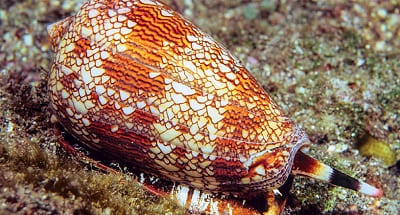Home › A-Z of Scuba › Diving Injuries › Cone Snail Sting
Treatment for Cone Shell Sting
The conical shell of some 600+ cone snail species (Conidae) disguises the actual danger of these marine gastropod mollusks to humans.
This guide explains why you should never handle the cone-shaped shell, and the signs and symptoms of cone snail sting after it injects the potent neurotoxin.
Hidden Risks of Handling Cone Snail Shells
The beautiful patterns and the coiled shells of these marine gastropods (slugs and snails) is what makes them so 'collectible'.
Most of the dangerous species of cone snails live in parts of the Indian and the Pacific oceans.
Even so, you can also find certain species in the Red Sea, off the coast of Florida, and in the Caribbean.
All of these creatures (more than 600) are poisonous - and they can all inject a venomous conotoxin.
You can find them living in the shallow reefs of tropical and subtropical waters. But, they tend to bury part of their shell in sandy sediment (e.g. coral substrate around rocky outcrops).
When a cone snail extends its proboscis (a long flexible tube) it can administer a sting using the venomous, almost harpoon-like, radula structure.
Pro Tip: It is not one of the most frequent scuba injuries, but all cone snail species can cause envenomation. So, divers should avoid handling all species of marine snails (shelled gastropods) to avoid severe complications.
Cone Snail Sting Symptoms
Some victims have described the sting from peptide toxins as causing mild to moderate pain, similar to that of the bite from a blue-ringed octopus.
Other severe manifestations can appear within only a few minutes and may often include:
- Blurred vision
 Diplopia (double vision)
Diplopia (double vision)- Skin reddening and swelling (like a blood blister)
- Intense pain
- Numbness and tingling sensations
- Malaise (weakness)
- Chronic wound with ulceration
- Muscular paralysis
- Respiratory failure (heart stops)
- Death (rare but can occur within 8 hours)
There is no antivenin or specific treatment available to treat cone-snail envenomation. Instead, first aid treatment will focus on pain relief. In general, human fatalities from cone shell stings will depend on:
- The size and susceptibility of the victim.
- How much venom was injected.
- Which species is involved and the mixture of substances (e.g. tetrodotoxin and up to 100 other toxins).
Treatment for Cone Snail Stings
Most scuba divers already know that passive interaction with aquatic animals is the safest way to avoid marine life injuries.
As a result, fatal incidents from cone snail envenomations are not common in diving. But, conchologists and shell collectors will be placing themselves at a higher risk.
If a scuba diver or snorkeler gets stung by a cone snail, seek medical attention from the nearest treatment centre, and:
- Clean the wound site with fresh water and provide first aid care for the small puncture wound.
- Use the appropriate pressure immobilization technique when applying a tight bandage to reduce the spread of venom (e.g. like sea snake bites).
- The application of heat for bites and stings often helps with pain management. But, tetrodotoxin (TTX) is a heat-stable toxin.
- Be mindful of signs and symptoms of slowing body movement (progressive paralysis). You may need to use a respirator to provide mechanical ventilations (e.g. with a bag valve mask (BVM) or a manually triggered ventilator (MTV)).
- Bite sites from cone shell stings can be painless but still toxic and lethal. Thus, monitor patient consciousness (airway and breathing) and begin cardiopulmonary resuscitation (CPR) if it becomes necessary.
Cone Shell Sting Special Considerations
The pressure bandage should not occlude the circulation (the fingers/toes beyond the bandage should remain pink and with normal sensation). The bandage should be left in place until proper medical support is available.
Pro Tip: Anyone who is running a dive school will have a duty of care for helping injured divers. So, use common sense and be prepared to have them evaluated by a medical professional.
Related Information and Help Guides
- Blue Ringed Octopus Bite Symptoms and First Aid
- Fire Coral Sting Symptoms and Treatment (Millepora alcicornis)
- Fish Spine Injury First Aid Treatment
- Jellyfish Sting: Stinging Hydroids and Coral Anemones
- How to Treat Crown of Thorns Starfish Sting
Note: The short video [2:39 seconds] presented by National Geographic contains deadly footage of a cone snail paralysing its prey (a blenny fish).